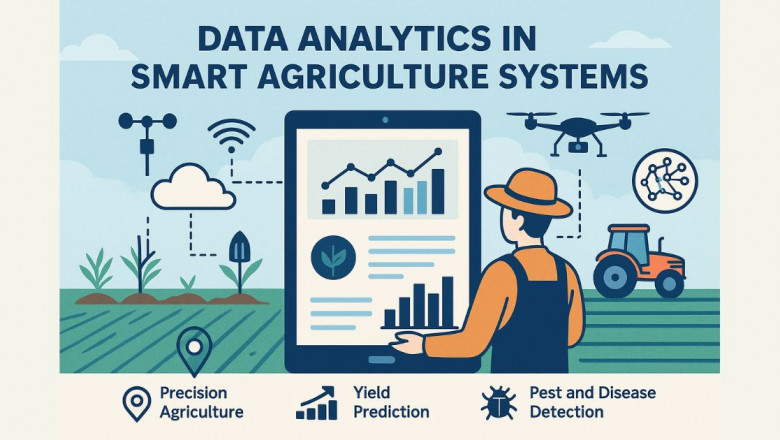views
In recent times, the agricultural industry has undergone a fundamental transformation due to the adoption of cutting-edge technologies. One of the most transformative developments is the Smart Agriculture System Using IoT, which combines data analytics, sensor networks, and cloud computing to optimize farming practices. With increasing concerns about food security, climate change, and the need for sustainable farming, smart agriculture is emerging as a critical solution to modern agricultural challenges.
The Role of Data in Agriculture
Traditionally, agriculture relied heavily on intuition, experience, and manual labor. While these methods have stood the test of time, they often lack precision and adaptability to changing environmental conditions. The rise of digital technologies enables farms to produce large volumes of data from numerous sources, including soil sensors, weather stations, satellite images, and machinery records.
This raw data, however, is only valuable when properly analyzed. That’s where data analytics plays a central role. By leveraging analytical tools, farmers can gain insights into crop performance, irrigation needs, pest risks, and optimal planting and harvesting times.
What is a Smart Agriculture System?
A Smart Agriculture System is an integrated platform that utilizes modern technologies—such as IoT devices, big data analytics, machine learning, and cloud computing—to monitor, manage, and enhance agricultural activities. These systems offer a more efficient way to cultivate crops by collecting real-time data and enabling informed decision-making.
For example, a smart agriculture setup might include soil moisture sensors connected to a central system. When the soil becomes too dry, the system can automatically trigger irrigation. Simultaneously, the data collected is analyzed to improve future water use and reduce waste.
Components of Smart Agriculture
Smart agriculture typically include the following components:
1. Sensors and IoT Devices
Sensors are placed in fields to monitor soil moisture, temperature, humidity, and other environmental variables. These devices send real-time information to a central system using Internet of Things (IoT) technology.
2. Data Storage and Cloud Platforms
Collected data is stored securely on cloud platforms, making it accessible from anywhere. This enables farm managers and agronomists to remotely monitor and manage agricultural operations.
3. Data Analytics and Machine Learning
Raw data from sensors and devices is processed using advanced analytics and machine learning algorithms. These tools identify patterns, predict outcomes, and offer recommendations to improve farm productivity and efficiency.
4. Automated Control Systems
Based on insights from analytics, automated systems can be deployed for tasks like irrigation, fertilization, and pest control, reducing human effort and improving precision.
Applications of Data Analytics in Smart Agriculture
Data analytics is the backbone of intelligent farming practices. Some key applications include:
- Precision Agriculture
Precision agriculture involves applying inputs like water, fertilizers, and pesticides in precise amounts and locations. Data analytics enables this by analyzing field variability, crop health, and growth stages. It guarantees that resources are utilized efficiently, lowering expenses and minimizing environmental effects.
Predictive Maintenance
Agricultural machinery like tractors and irrigation systems is fitted with sensors to track performance. Analytics can predict potential failures or maintenance needs, helping prevent downtime and ensuring operational continuity.
Yield Prediction
Analyzing historical data, weather conditions, and soil health allows for accurate yield prediction. This helps in planning storage, transportation, and market distribution in advance, minimizing losses.
Pest and Disease Detection
Machine learning models trained on image and sensor data can identify early signs of pest infestations or diseases. Early detection enables targeted interventions, reducing the need for broad-spectrum pesticides and preserving crop health.
Benefits of Data-Driven Agriculture
Implementing data analytics in smart agriculture offers numerous benefits:
- Increased Productivity: Farmers are able to make more educated choices, resulting in improved crop production and effective resource management.
- Cost Reduction: Automation and precision reduce input waste, leading to significant cost savings.
- Sustainability: The effective management of water, fertilizers, and pesticides contributes to minimizing the ecological impact of agricultural activities.
- Risk Management: Predictive analytics allows for better risk assessment related to weather, pests, and market conditions.
Challenges in Adoption
Despite its potential, several challenges hinder the widespread adoption of data analytics in smart agriculture:
- High Initial Costs: The installation of sensors, IoT devices, and data processing infrastructure can be expensive.
- Technical Expertise: Farmers often need training to use digital tools effectively, which can be a barrier in rural areas.
- Data Security: With increasing data collection, protecting sensitive agricultural data from breaches and misuse becomes critical.
- Connectivity Issues: In many regions, especially remote agricultural areas, internet connectivity remains a significant challenge.
Future Outlook
The advancement of farming depends on making decisions based on data analysis. As the cost of IoT devices and cloud storage continues to fall, smart agriculture will become more accessible to small and medium-scale farmers. Additionally, improvements in artificial intelligence and blockchain technology are expected to improve transparency, traceability, and automation within agriculture.
Partnerships among governments, technology firms, and agricultural organizations will be crucial in developing intelligent infrastructure and equipping farmers with essential support and training.
Conclusion
The incorporation of data analytics into agricultural practices represents a groundbreaking advancement for more efficient, sustainable, and productive farming. Although the Smart Agriculture is still developing, its ability to change the agricultural sector is clear. By utilizing data and technology, agriculturalists can improve their crop production while also contributing to global food security and environmental protection.






















Comments
0 comment